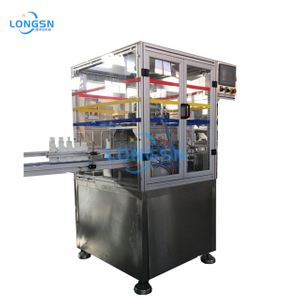In an age where sustainability and recycling are becoming vital priorities, polyethylene terephthalate (PET) bottles play a central role in the fight against plastic waste. PET bottles are commonly used for water, soda, oil, and other liquid packaging, making them one of the most widely recycled plastic types in the world. Yet, the efficiency of PET bottle regeneration — the process of converting used PET bottles back into reusable materials — is often limited by a small but significant factor: the bottle neck.
This article explores how bottle neck cutting machines can significantly enhance the efficiency of PET bottle regeneration. We will explain their purpose, operation, and benefits, offering a detailed and easy-to-understand look at their crucial role in modern recycling systems.
Understanding PET Bottle Regeneration
To understand the importance of bottle neck cutting machines, it's essential to first look at how PET bottles are regenerated:
Collection: Used PET bottles are gathered from homes, businesses, and recycling centers.
Sorting: Bottles are sorted from other plastics and impurities, ensuring the batch is PET-dominant.
Washing: They are thoroughly washed to remove dirt, labels, caps, and residues.
Cutting/Shredding: Bottles are cut or shredded into small flakes.
Separation: Flakes are separated by density to remove remaining labels or cap particles made from other plastics like HDPE or PP.
Melting and Repelletizing: Clean PET flakes are melted and reformed into pellets for reuse in new products.
While this process is relatively efficient, one persistent challenge is the bottle neck, which is often made of different material and designed with additional components. These necks can hinder the regeneration process in several ways, reducing both the quality and volume of recovered PET.
The Challenge: Why the Bottle Neck is a Problem
Though small in size, the neck of a PET bottle often introduces several complications in the recycling process:
Material Incompatibility: The neck and cap are frequently made of materials such as HDPE or PP, which do not melt at the same temperature as PET. Mixing these with PET lowers the quality of the recycled output.
Extra Thickness: The neck region is generally thicker and more rigid, requiring more energy to shred or melt.
Contaminants: Caps may contain silicone seals, rubber rings, or even metal parts in pump-style dispensers.
Label Adhesives: The upper portion of the bottle is often covered with stubborn adhesives or shrink-wraps that are difficult to remove during washing.
These issues mean that PET flakes mixed with neck material may not meet purity standards, particularly for food-grade or medical-grade recycled PET. To overcome this, recycling facilities often manually remove bottle necks or use less efficient sorting methods — both costly and time-consuming.
Enter the Bottle Neck Cutting Machine
A bottle neck cutting machine is a specialized piece of equipment designed to cut and separate the neck of a plastic bottle — typically just below the screw thread — before it enters the shredding or regeneration line. It operates automatically, processing hundreds to thousands of bottles per hour.
These machines are equipped with adjustable settings to accommodate various bottle sizes and are often used before the shredding stage in recycling facilities or in bottle manufacturing plants to trim imperfect necks.
How Bottle Neck Cutting Machines Work
A modern bottle neck cutting machine operates using the following steps:
Bottle Feeding: Bottles are either manually loaded or automatically conveyed into the machine.
Orientation and Positioning: Guides or sensors align the bottle to ensure precision during cutting.
Rotary Cutting: A fast-spinning or circular blade cleanly slices off the neck at a preset height.
Separation: The cut neck and the remaining body are collected in separate bins for further processing.
Output: The body of the bottle — now free of contaminants — proceeds to the shredding or flaking stage.
Advanced models are controlled by PLC systems (Programmable Logic Controllers) and have touch-screen panels for ease of use and fine-tuning.
Ways Bottle Neck Cutting Machines Improve PET Regeneration Efficiency
Now let’s explore how these machines enhance the overall PET recycling process:
1. Improved Material Purity
One of the most significant benefits of removing bottle necks is higher purity in the PET flake output. When necks made from PP or HDPE are removed before shredding, there's less chance of contaminating the PET stream. This is especially critical for industries that require food-grade or pharmaceutical-grade recycled PET, where even small impurities can lead to rejection of the whole batch.
2. Better Shredding Performance
Bottle necks are generally tougher and thicker than the rest of the bottle. When they are removed in advance, shredding machines encounter less resistance, reducing wear and tear on the blades. This not only extends the lifespan of expensive machinery but also allows for faster processing speeds and more uniform flake size.
3. Lower Energy Consumption
Cutting off the necks reduces the energy required for downstream operations like shredding and melting. Thicker neck materials take longer to process and require more energy to break down. By removing them early, overall energy consumption drops, making the process more environmentally friendly and cost-effective.
4. Increased Throughput
Without having to deal with troublesome necks, machines can process bottles more rapidly. This leads to greater throughput, allowing recycling plants to handle more volume in the same amount of time. For large-scale facilities, this translates to higher profitability and more recycled material in circulation.
5. Reduced Labor Requirements
In some recycling operations, workers manually trim off bottle necks using knives or scissors. This is labor-intensive, slow, and potentially dangerous. Bottle neck cutting machines automate the entire process, leading to fewer worker injuries, lower labor costs, and more consistent results.
6. Easier Sorting and Separation
When necks are removed and collected separately, they can be processed based on their material. For example, HDPE necks can be recycled in a separate stream. This material streamlining supports more sophisticated recycling practices and higher-value recovered plastics.
7. Enhanced Product Quality
The final PET pellets or flakes produced after removing necks are cleaner, more uniform, and of higher quality. This opens the door to their use in more demanding applications, such as:
Manufacturing of clear PET bottles
Production of polyester fibers for textiles
Use in food and beverage containers
Creation of high-strength packaging films
Key Features of High-Performance Bottle Neck Cutting Machines
To be effective in a PET regeneration setting, bottle neck cutting machines must be:
Highly accurate: Capable of cutting at the precise location regardless of bottle size.
Fast and efficient: With a processing capacity of 800–1100 bottles/hour or more.
Flexible: Adjustable for different bottle sizes and materials.
Durable: Constructed from stainless steel or aluminum for long service life.
Safe: Equipped with emergency stops and blade covers to prevent accidents.
Smart: Controlled by PLC systems with user-friendly touchscreens.
Manufacturers like Zhangjiagang Longsn Machine Co., Ltd. offer machines that meet these requirements, making them a trusted choice in the global recycling and packaging industry.
Environmental and Economic Impact
By enhancing the efficiency of PET bottle regeneration, bottle neck cutting machines contribute significantly to environmental sustainability and economic growth:
Reduced Plastic Waste: More PET bottles are effectively recycled instead of ending up in landfills or oceans.
Lower Carbon Emissions: Less energy use means fewer greenhouse gases emitted during processing.
Support for Circular Economy: High-quality recycled PET can re-enter the production cycle, reducing dependence on virgin plastic.
Increased Profit Margins: Cleaner output materials can be sold at higher prices, improving business outcomes for recyclers.
Real-World Applications
In the recycling industry, bottle neck cutting machines are used in:
Material Recovery Facilities (MRFs): To prepare PET bottles for sorting and shredding.
Plastic Washing Lines: As a pre-treatment stage before intense cleaning processes.
Bottle Manufacturing Plants: For quality control and post-mold trimming.
Export Quality Control: Where recycled materials must meet international purity standards.
Conclusion
The regeneration of PET bottles is a cornerstone of modern plastic recycling. However, achieving high efficiency and quality in this process requires more than just basic shredding and melting. The bottle neck, often overlooked, presents a real challenge in maintaining material purity and processing speed.
Bottle neck cutting machines offer an intelligent, effective solution. By removing the problematic upper portion of the bottle early in the recycling process, these machines help deliver purer materials, improve throughput, reduce costs, and support better environmental outcomes.
In a world that increasingly values sustainability and efficient recycling, bottle neck cutting machines play an essential — and transformative — role in PET bottle regeneration. They are not just machines; they are key enablers of a cleaner, more circular plastic economy.

 English
English









